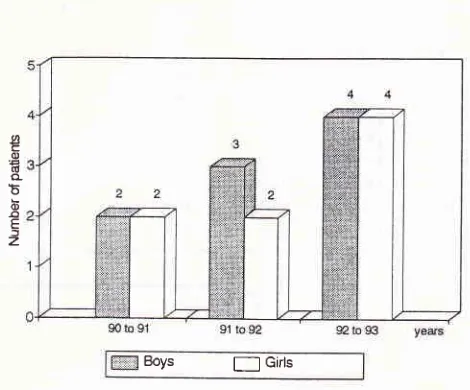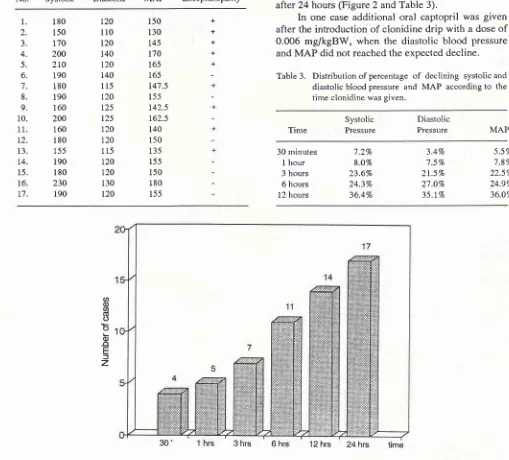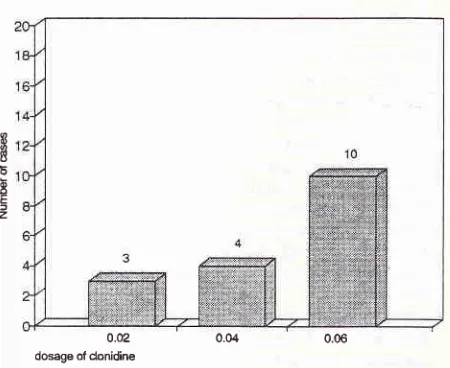226
Alatas er aI. MedJ
Univ lttdotrThe
Effect
of
Clonidine
Drip
in
Hypertensive
Crisis
in Children
H.
Alatas, Huda Farida,
I.G.N Wila Wirya,
T. Tambunan,
P.Trihono
Abstrak
Drip klonidin diberikan pada 17 kasus hipertensi (9 ntengalani ensefalopati hipertensifl yang dirawat di Bagian IImu kesehatan Anak FKTJI/RSCM dari Maret I99O sanpai Pebruari 1993. Penyakit dasar penderita ialah
:
7 dengan glomerulonefritis akut, 4 gagalginjal krontik,2 infeksi saluran kenùh kotnpleks,
I
penyakitTakayæu,t neningitis
virus,I
gagaliantung (MI, MS' ec RHD) danI
etiologi tak diketahui. Drip klonitlitt diberikan secara titrasi,dinulni
dengan dosis 0,0O2 tng/kgBB/8 iatn dalamlN
cc dekstrosa 5% dengin tetesatT awal 12 tetes/nenit bersana denganfurosenid IV 1 ng/kgBB/8jatn. Tetesan dinaikkan dengan kelipatan 6 tetes setiap 30 menit hingga dosis nruksirnal 36 tetesy'nenit Q,AO6 nrylkgBB) sanrpai teknnan.diastolik turun < 100 nntHg atau MAP < 93 nunHg. Bila halini
belutn rercapaidi
tatnbah dengan kaptopril oral. IJsia penderita berkisar antara 5-
13 tahun (rata-rata 9 7/12 tahun)' takiJaki 9, peretnpuan 8 orang. Setelah 3O tnenit penberian klonidin terdapat penurunan lekanan darah pada 4 kasus (23'5%)' Iian
pada5
kasus (2g,57"), 3 jan pada 7 ktsus (41,2%), 6jan
padn 1I
kasus (64,7Vo) 12 jan padal4
kasus (82,3%) dan lebih dari 24 ianr pada3
kasus (17,6%). Dengan dosis klonidin 0,AO2 ug/kgBB teknnan darah dapat diturunkan pada3
kasus (17,6 %), dosis 0,OO4 tttg/kgBB pada4
kasus (23,5%), dan dosis 0,006 tnglkgBB padal0
kasus (58,9%)- Pada satu kasus ditanbah kaptopril oral karena setelah diberi klonidin dosisnaksinnl
tekanan darah belunr tur.u.n. Tekruran darah turun secara bertahap sejak 3O ntenir serclah pentberial klottiditt dan setelah 6 jan penberian kloniditt tekanan sistolik turun 24,3 %, diastttlik 277o dan MAP 29,7%- Dalan 24 iam pertat,ru teknnan darah diastolik turun <l0o
rutttHg pada 14 dari 17 penderita. Selama penelitian tidak diiutnpai gejala efek saniping obat yang jelas. Disinpu.lkan bahw,a drip klonidin beruanfaat untuk nenururtkan tekanan darah secara cepat pada krisishipertensi-Abstract
Clcttridine drip was given to 17 patients with hypertensive crisis (9 cases showed hypertensive encephalopathy) adnitted to the Departtrtent qf Child Heahh of the Ciltto Mangunkusunrc Hospital during a 3-year perod (March 1990 ut'ttil February 1993). Various etiologies
of
the hypertension were encountered:
7
cases were du.e to acute glomerulonephrifis,4
u'irh chronic renal .failure' 2 cottqtlicated urinarl,tract infectiott,I Takayasu's disease,
I
viral neningitis,I
acute cardiac deconrltensation (rheunatic heart disease) and I of unknow,n etioktgl. Clotritline was adtninisrered by titration v,ith an initial dose of 0.002 ntg/kgBW every 8 hours in a l0O nrL 5% dettrosasolurion, îogether u,ithfurosettùtleI
nrg/kgBW given every 8 hours intravenou.sl)'. Thedrip
v'as increases eveôll/2
hour u.ntil the diastolic pressu.re decreosedto less
than l0OnnHg
or the nteotl arterial pressure (MAP) reached less than 93 ttttttHg- The tnarittnL dose of clinidine was 0.006 tng/kgBfl8 hours.If
no reductiott in dirLstolic pressure u,k\ obtained until the tnatirtnl dose was reached, captopril v,as suppletttented orally. The age ofthe children v,as betv,een 5-13 years (nean age 9 7/12), cottrprising of 9 bol's and8
girls. The results of trearrnent showed that blood pressure decrersed in 4 cases (23,5%) after 30 uittuteq 5 cases (29,5%) a.fter 1 hour, 7 cases (41 .2%) aft.er 3 hou rs, II
cases (64.7%) afier 6 hours,I4
cases (82.3 %) after 12 hou rs v'hile in 3 cases ( I 7.67") ir decreased after 24 hours of clortidine adtttittistratio,'t. The clonidine dosage usedin
this study wrts 0,0O2n{kgBW
in3
cases (17,6%), 0,004 ttrg/kgBW in4
cases (23.5%) and 0.006 tng/kgBW itrI0
cases (58.9Vo). Ccpropril wrLs added orally in onll, I çtcs. The onset of effect u.po,'t the blood pressure was 30 tttinutes after clonidine adrninistratiotr. After 6 hours of adninistratirtn the.slstollc blood pressure decreased 24.3% the diastolic blood pressure 277o and MAP 29.7%. Within 24 hoursl4
out of 17 cases shou'ed a decrease in diastolic blootl pressu re less than l0O ruttrHg. No obv,ious sideffict
u,as detected du ring the studl'. ltr cotrclu.sion clinidine drip shttv'ed a prorttisittg effect in the trealnent o.f hyperrensive cri.sl.s in chiklren.Keywords : Clotridine drip, H1'pertett.siue crisis, Hy'pertensive encephalopathy
INTRODUCTION
Hypertensive crisis
in children
is
arelative
rareemer-gency
condition, which is in
accordancewith
the
in-cidence
of
hypertension
in
children
which
is
lessfrequent
comparedto
adults,Up
till
now
there is no report availeble concemingthe
incidence
of
hypertensive
crisis ir, children in
Vol 3, No 4, October-Decenber 1994
few
yearsmuch attention
has beengiven
to
hyperten-sioninchildren.
This isattributedtothenotionthat
manyvictims of
adult hypertension started sincechildhood or
adolescence,
In
Jakarta the prevalenceof
hypertensionin
children
is
about 3.ll7oz
while
in
adults
it
is14.2To.3
Hypertension
in children is
often secondary
andthe
morbidity is
associatedwith
theprimary
disease. The presenceof
hypertensive crisis
in
children is
con-sidered an emergencycondition
and theblood
pressure hasto
be reduced as soon aspossible
toprevent
unex-pected
complications, such
as hypertensive
en-cephalopathy.
If
apatient with
hypertensive
crisis
isnot
managedproperly,
most
of
them
will
die
within
aperiod
of
6 months.aThe objective
of
this study was to
evaluate
theeffect of clonidine
in
17hypertensive crisis in children
with
various etiologies
andwith
specialattention
io thetime
lag of
lowering
the blood
pressure,drug
dosageand the possible side effect
encountered
during
the treatment.PATIENTS AND
METIIODS
To all
children
with
the diagnosis
of
hypertensive
crisis, admitted
to theChild Health Department,
Facul-ty of
Medicine, University
of
Indonesia,
Dr.
Cipto
Mangunkusumo Hospital,
Jakarta,during
the periodof
March
1990
up
till
February
7993,
were
given
clonidine drips
as treatment.In
this study hypertensive crisis
wasdefined
as asystolic blood
pressureof
180mmHg
or
more and
adiastolic
pressureof
l2OmmHg or
more
or
when
thesystolic
pressure
was
less
than
l8O mmHg,
and
thediastolic
pressure less
than
120
mmHg,
but
accom-panied
by
symptoms
of
encephalopathy, cardiac
decompensation
or
papil
edemaof
the eyes,The
patients were
treatedaccording
to a standardprotocol
atour Child
Health Department, i.e.
titration
of
clonidine
drip with a
starting dose
from
0.002mg/kgBW
every
8hours
in
100ml
5% dextrose
with
an
initial drip
of
12 per minute along
with IV
furosemide
of
I
mg/kgBW
every
8 hours.The
drip
were increased 6drips every
30minutes
until
a maximal
of
36 drips/min
was
reached(0.006
mg/kgBV/)
andthe
diastolic
decreasedto
IOOmmHg
or less or themaximum arterial
pressure(MAp)
to lessthan
93 mmHg.
If
with
this mode
of
treatment
theexpected decrease
in
diastolic
pressure
was not
reached,
additional oral captopril with
an
initial
doseof
0.3
mg/kgBW/time, 2-3
times
daily
wasgiven
andif
necessary this dosecould
be increased to amaximum
of
2mg/kgBW
each time.5Observation and evaluation were done
to
theamount
of
drug required, the
tinte
lag
between
theClonidine
Drip
itt Hl.perterciveCrisis
227introduction of
thedrug
andthe
lowering
of diastolic
blood
pressure toreach
100mmHg or
lessor
theMAp
less than 93mmHg,
and the possible sideeffects of
the drug.RESULTS
Since
March
1990till
March
1993,17
casesof
hyper-tensive
crisis
fulfilled
the
criteria
of diagnosis,
com-prising
9boys
and 8girls.
The
distribution
of patients each year was depictedin Figure
l. Thc
ageof
patients rangedfrom
5- I 3 yearswith
a meanof
97ll2
years.From
the2i
patientswith
hypertensive crisis the most common
cause was acuteglomerulonephritis (AGN) i.e. 7 out
of
17 cases andmost
of their
ageswere between
5-7
yearsold, which
consisted
of 5
patients.
While
patients
with chronic
renal failure (CRF) were
encountered
at
older
ages(l
l-13
years)i.e.
3out
of4
patienrs(fable
1).Boys
f-l
cirtsFigure
l.
Arutual distributiott of h;'pertensit'e patients accord-ingto
sex, cort4tiled u,ithin3
1,ears,from March
1990till
February 1993.Table
l.
Distribution o[ hypcrtcnsivc paticnts according to and their primary diseasesPrimary disease
Age
5-7 ycars 8-10 ycars I l-13 years Total
AGN CRF
Conrplicaled UTI Takayasu's discase Viml nrcningitis Car<liac dccompcnsation Unknown
2 I a
c o d o b o o E J
z
7
34
t)
[image:2.595.307.542.336.531.2]228
Alatas et al.From Table 2
it
could
be seen the height
of
thehypertension
on
admission. Hypertensive
encepha-lopathy
was foundin
9 cases.After
30 minutes of clonidine drip thesystolic pressure
reducedtoi
.27o,the diastolic pressurereducedto3.4To
and theMAP to
5.57oin
4 cases (23.37o).Table
2.
Distribution of the heightof
blood pressureon
17 patients on admission withor
without symptoms ofhypertensive encephalopathy
No. Systolic Diastolic
MAP Encephalopathylvled J Univ Indon
After I
hour treatment thesystolic blood
pressure decrea5edlo
870,the diastolic
pressure
lo
7,57o and
MAP to 7.8% in 5
cases(29.4%).
After 3
hours the
systolic blood
pressure decreasedto
23.6%,
diastolic
pressure
to
21.57o
and
MAP
to
22.57o
in 7
cases(41.2%).
After 6
hours the systolic blood
pressure decreasedto
24.37o,diastolic
pressurelo
27 .O% andMAP
decreasedto
24.9%
in
ll
cases(64.770).
Afler
12
hours the systolic blood
pressure was decreased to 36.470, thediastolic
pressureto 35,1%
and theMAP
decreasedlo
36,07oin
14 cases
(82.47o).In 3
cases(17.67o) the
systolic and diastolic blood
pressuretogether
with the MAP
reached
the
expected height
after 24 hours
(Figure2
andTable
3).In
one case
additional
oral captopril
was given
after
theintroduction of clonidine drip with
a doseof
0.006
mg/kgBW, when the diastolic blood
pressure andMAP
did not reached the expected
decline.
Table
3.
Distribution of percentageof
declining systolic anddiastolic blood presstrre and MAP according
to
thetime clonidine was given.
Time Systolic Pressure MAP
l.
2. 3. 4. 5. 6. 7. 8. 9. 10. 11. 12. 13.t4.
15. 16. t7. 180 150 t'70 2002ro
190 180 190 160 200 160 180 155 190 180 230 190 r20 110 t20 140 120 r40 115 120 r25 125 120 t20 115 120 r20 130 120 150 130 t45 170 165 165 147.5 155 142.5 162.5 140 150 135 155 r50 180 155 + + + + + Diastolic Pressnre30 minutes
I
hour3 hours
6 hours
l2
hours1.270 8.OVo 23.6% 243% 36.4Vo 3.4Vo 7.5To 21.5% 27.O7o 35.lVo 5.5Vo 7.8Vo 22.5% 24.9% 36.OTo
oo
aiI
b
o
o
E fz
'12 hrs 24 hrs time
Figure 2. Distributiotr of the nwnber of patiens v,ho reached the diastolic pressu re of less than l0O nnt H g according to
[image:3.595.63.572.252.712.2]B
o 3
E
t z
VoL 3, No 4, October-Decenber I994
Table 3
showed
the
percentage
of
reduction
in
systolic
and
diastolic blood
pressure
along
with
theMAP
after
clonidine introduction for
30minutes,
l,
3,6
and 12 hours.It
was evident that from the dosis
of
clonidine
introduced
theblood
pressurecould
be decreasedin
3cases
(17.6%)
with
0.002 mg/kgBW, and
4
cases(23.5%)
with
a doseof
0.004
mg/kgBW
and
10 cases(58.9%)
with
0.006
mg/kgBW
(Figure
3).o.t2
0.04
0.06 [image:4.595.62.287.214.398.2]dosge of donidine
Figure 3. Distributiott of blood pressure decrease in
l7
casesin reLatiotr with clonidine dosage.
During the
study
no
serious side
effect
like
bradycardia
was encountered.In
3children
drowsiness wasfound, but
it
wasstill doubtful
whether
it
was due to thedrug
or to theseverity of
theunderlying
disease.DISCUSSION
Since the last 5 years
clonidine drip
treatment has beenintroduced
to
hypertensive
crisis
patients
in
the
Pediatric
Nephrology Ward,
Cipto
Mangunkusumo
Hospital,
Jakarta.
During the period
of
March
1990until
February 1993,
l7
casesof
hypertensive crisis
were
detected and received
clonidine
drip
treatmentaccording
to
the standard
protocol. Figure
I
showedthat there was
a
tendency
of
increasing number
of
patients
with
this
diseasefrom
yearto
year.Most
hypertensive
casesin children (+
857o) are secondary inorigin,
expecially
caused byparenchymal
renal disease.a'6.As
shown
in this
study
the
most common
cause wasacute
glomerulonephritis
at the ages between 5-7 years (5 cases) andchronic
renalfailure
atolder
ages,I
1-13years
(3
cases).In
one case the causeof
hypertension
could not be
deternrined
and was
considered
as
anessential one.
Clotridine
Drip
itr H)tpertensiveCrisrs
229.From
theprevious study,
during
a3-yearperiod,
78 cases
with
renalhypertension
were encountered.Of
these 12 were hypertensive crisis patients,
7
were
causedby
AGN,
I
casewith nephrotic syndrome,
I
chronic pyelonephdtis
and 3with
renovascular
hyper-tension.'
Out
of
the
17
cases
with
hypertensive crisis
during the
3-year study,
9
cases
(52.97o)
showed
symptoms
of
hypertensive encephalopathy. This
find-ing
wasin
accordancewith
thereport
in
the literature
that hypertensive encephalopathy was
themost
com-mon
complication
encounteredin
children.T'8Regardless
of
theetiology, \zpertensive
crisis is
con-sidered
acondition which
need animmediate
andin-tensive management. The
objective
of
the treatmentof
these casesis to lower
the
blood
pressure assoon
aspossible
to
normal
in
order
to
prevent the
possible
complication
causedby
thevery high
andlong lasting
blood
pressure such as the target organsof namely
thebrain,
heart, eyes and thekidneys.
Until
recently
there isstill conflicting
evidenceof
how low
theblood
pressure has to be decreased.Zim-mermang
"ugg"rt.d
a lowering
of
the
blood
pressureuntil
the meanarterial
pressure wasabout
120mmHg,
a decreasein
systolic
pressure 2O-4O%or
adiastolic
pressure
of
100mmHg.
On
theother
hand Kaplana proposed a decreasedof
257oof
theblood
pressureor
adiastolic
pressureof
100-
'
Il0
mryrHgwithin
afew
minutes or
hours.Dillon)
suggesteda
decreaseof
onethird
of
theexpected
blood
pressure
height
in
the
first
6
hours, anotheronethird
decreasewithin
thenext
12-36 hours andonethird
of
therest
within 2-4 days.In
this study
after theintroduction
of clonidine
thesystolic
pressure decreasedto24.37o,
thediastolic
pressureto27%
and theMAP to29.-l% within
6 hours.This
wasin
accord-ancewith
the target expectedin
the literature.
Within 6
hours
the diastolic blood
pressure
decreasedto
lessthan
100
mmHg
in
11 casesand
3 cases reachedthis level after 6
hours later.
Only
in
3other
cases
the expected
blood
pressure could
beachieved
after 24 hours.Clonidine
as anantihypertensive drug
belongsto
a groupofalpha-adrenergic
agonist and has apenetrat-ing
activity
to
thecentral nervous
system and reduces theeffect
of
sympathic
systemlike
alpha-methyldopa.
Allhough clonidine did
not
work directly
but
thetime
allotted
to decrease theblood
pressure waseffective
tomost patients and
could
be
usedin
emergency
cases.Using this drug intravenously in drip form,
asin
this
study,
it
showed that
clonidine
was reasonably
effec-tive
in
lowering
tlreblood
pressure.In only
onepatient
additional oral
captopril
was needed because the23O
Alatas et al.The
use ofclonidine
drip in the
managementof
patients with hypertensive
crisis have
been asfar not
yet
reported
in
the
literature.
It
had been used
asreported
in
the literature
in
the form
of
intravenous
bolus.
Using this drug
in drip form the lowering of
theblood
pressurecould be easily controlled in order to
prevent
the serious sideeffect
of hypertension.
CONCLUSION
l.
Clonidine drip
was considered reasonablyeffective
to lower
the blood
pressurein hypertensive crisis
patients.
2.
The most common
causeof hypertensive
crisis in
chlldren
was acuteglomerulonephritis.
3.
After 6 hours
of
clonidine drip the systolic
blood
pressure was
decreasedlo 24.3%,diastolic
pressurets27%
and the N'[AP 29.7%.4.
The diastolic blood
pressure lessthan
100mmHg
can be achieved after
6
hours
of
clonidine
ad-ministration
in
11 cases (64.7 7o),14 cases(82.3%)
after 12 hours and
in
3 cases(I7 .6%) after24
hours.5.
The diastolic
pressure
decreasedto
lessthan
100mmHg
with
a dosageof
0.002clonidine
in
3 cases,0.004 mg in
4 cases and0.006 mg
in
l0
cases.REFERENCES
1.
Alatas H, Wila Wirya IGN, Tambunan T. Management ofrenal hypertension in children in lakarta. Proceedings ofthe
Med
J
Univ lndon3'd colloquium in Nephrology, Tokyo; 22-23 Oktober 1979: 19À200.
2.
Wila
WiryaIGN,
AlatasH,
TambunanT,
Hermanses S, Windiastuti E. Studies of blood pressure and prevalenceof
hypertension in school children in Jakarta, Pediatr Indones 1988;28: 183-91.
3. Sidabutar RP,
Wiguno P.
Hipertensi esensial. Dalam:Soeparman et al eds. Buku Ilmu Penyakit Dalam
(ilid
II).fakarta: Balai Penerbit FKUI 1990: 205-23.
4. Kaplan
NM.
Hypertensive emergencies and urgencies. In: KaplanH.M.,
ed. Clinical hypertension, Baltimore:Wil-liams and Wilkins, l99O:268-82.
5.
Dillon
MJ. Drug Treatmentof
hypertensionin:
HollidayMA, Barratt TM, Vernier RL eds. Pediatric Nephrology 2"o Ed. Baltimore: William & Wilkins, 1987: 758-65.
6. Alatas
H.
Krisis hipertensi pada anak dalam: Kumpulan naskah Simposium Nasional Nefrologi AnakII.
Surabaya:Ikatan Dokter Anak Indonesia Jawa Timur: 1983: 83-92. 7. Alatas, H. Ensefalopati hipe rtensif dalatn : Pusponegoro HD,
Passat
f.
eds.: Kedaruratan Saraf Anak. Naskah Lengkap Pendidikan Tambahan BerkalaIlmu
Kesehatan Anakke-XVtrI.
Iakama: Balai Penerbit FKUI, 1989: 109-19.8. Balfe JW, Rance CP. Recognition and management of hy-pertensive crisis in childhood. Pediatr Clin North Am 1978;
25:L59-74.
9. Zimmerman IL. Hypertensive emergencies in Mustafa, I ed
Proceedings of
the International
Symposiumin
Car-diothoracic Critical Care. Jakafta : Indonesian Society forCritical Care Medicine: 1991: 88-97.


